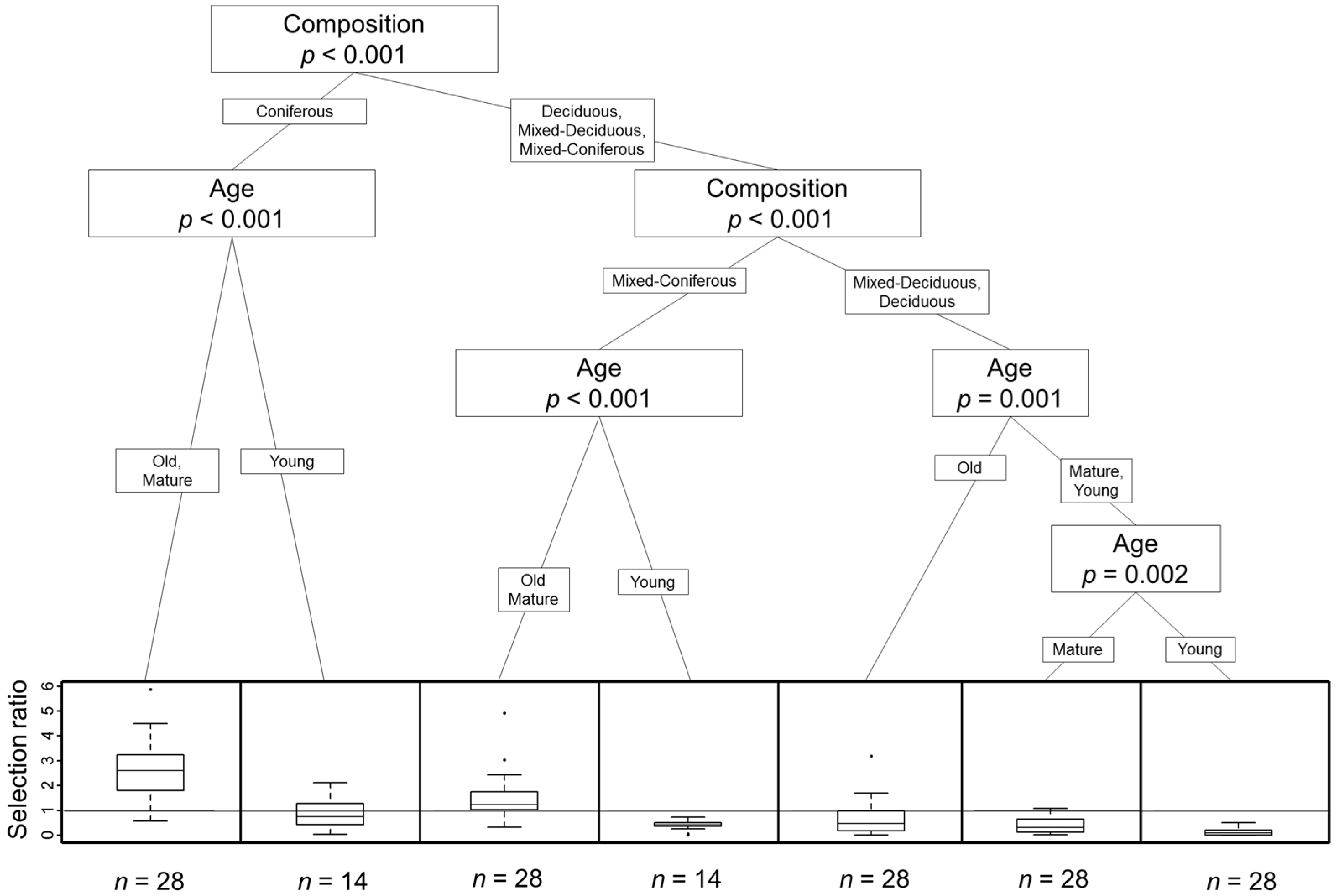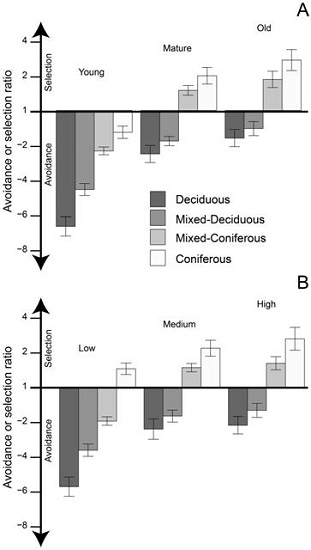Mapping Local Effects of Forest Properties on Fire Risk across Canada
Abstract
:1. Introduction
2. Materials and Methods
2.1. Region of Interest and Source of Data
2.2. Analytical Methods
3. Results
4. Discussion
5. Conclusions
Supplementary Materials
Acknowledgments
Author Contributions
Conflicts of Interest
References
- Rogers, B.M.; Soja, A.J.; Goulden, M.L.; Randerson, J.T. Influence of tree species on continental differences in boreal fires and climate feedbacks. Nat. Geosci. 2015, 8, 228–234. [Google Scholar] [CrossRef]
- Kurz, W.A.; Stinson, G.; Rampley, G.J.; Dymond, C.C.; Neilson, E.T. Risk of natural disturbances makes future contribution of Canada’s forests to the global carbon cycle highly uncertain. Proc. Nat. Acad. Sci. USA 2008, 105, 1551–1555. [Google Scholar] [CrossRef] [PubMed]
- Flannigan, M.D.; Logan, K.A.; Amiro, B.D.; Skinner, W.R.; Stocks, B.J. Future area burned in Canada. Clim. Chang. 2005, 72, 1–16. [Google Scholar] [CrossRef]
- Van Wagner, C.E. Age class distribution and the forest fire cycle. Can. J. For. Res. 1978, 8, 220–227. [Google Scholar] [CrossRef]
- Stocks, B.J. Fire behaviour in mature jack pine. Can. J. For. Res. 1989, 19, 783–790. [Google Scholar] [CrossRef]
- Cyr, D.; Gauthier, S.; Bergeron, Y. Scale-dependent determinants of heterogeneity in fire frequency in a coniferous boreal forest of eastern Canada. Landsc. Ecol. 2007, 22, 1325–1339. [Google Scholar] [CrossRef]
- Mansuy, N.; Gauthier, S.; Robitaille, A.; Bergeron, Y. The effects of surficial deposit-drainage combinations on spatial variations of fire cycles in the boreal forest of eastern Canada. Int. J. Wildland Fire 2010, 19, 1083–1098. [Google Scholar] [CrossRef]
- Kafka, V.; Gauthier, S.; Bergeron, Y. Fire impacts and crowning in the boreal forest: Study of a large wildfire in western Quebec. Int. J. Wildland Fire 2001, 10, 119–127. [Google Scholar] [CrossRef]
- Cumming, S.G. Forest type and wildfire in the Alberta boreal mixedwood: What do fire burn? Ecol. Appl. 2001, 11, 97–110. [Google Scholar] [CrossRef]
- Jiang, Y.; Zhuang, Q.; Flannigan, M.D.; Little, J.M. Characterization of wildfire regimes in Canadian boreal terrestrial ecosystems. Int. J. Wildland Fire 2009, 18, 992–1002. [Google Scholar] [CrossRef]
- Boulanger, Y.; Gauthier, S.; Burton, P.J. A refinement of models projecting future Canadian fire regimes using homogeneous fire regime zones. Can. J. For. Res. 2014, 44, 365–376. [Google Scholar] [CrossRef]
- Parisien, M.-A.; Parks, S.A.; Krawchuk, M.A.; Flannigan, M.D.; Bowman, L.M.; Moritz, M.A. Scale-dependent controls on the area burned in the boreal forest of Canada, 1980–2005. Ecol. Appl. 2011, 21, 789–805. [Google Scholar] [CrossRef] [PubMed]
- Beaudoin, A.; Bernier, P.Y.; Guindon, L.; Villemaire, P.; Guo, X.J.; Stinson, G.; Bergeron, T.; Magnussen, S.; Hall, R.J. Mapping attributes of Canada’s forests at moderate resolution through kNN and MODIS imagery. Can. J. For. Res. 2014, 44, 521–532. [Google Scholar] [CrossRef]
- Guindon, L.; Bernier, P.Y.; Beaudoin, A.; Pouliot, D.; Villemaire, P.; Hall, R.J.; Latifovic, R.; St-Amant, R. Annual mapping of severe forest disturbances across Canada’s forests using 250 m MODIS imagery from 2000 to 2011. Can. J. For. Res. 2014, 44, 1545–1554. [Google Scholar] [CrossRef]
- Gillis, M.D.; Omule, A.Y.; Brierley, T. Monitoring Canada’s forests: The national forest inventory. For. Chron. 2005, 81, 214–221. [Google Scholar] [CrossRef]
- R Core Team. R: A language and environment for statistical computing. R Foundation for statistical Computing: Vienna, Austria. Available online: https://www.R-project.org/.
- Robin, X.; Turck, N.; Hainard, A.; Tiberti, N.; Lisacek, F.; Sanchez, J.-C.; Müller, M. pROC: An open-source package for R and S+ to analyze and compare ROC curves. BMC Bioinform. 2011, 12, 77. [Google Scholar] [CrossRef] [PubMed]
- Manly, B.; McDonald, L.; Thomas, D. Resource Selection by Animals: Statistical Design and Analysis for Field Studies; Chapman and Hall: New York, NY, USA, 1993; p. 221. [Google Scholar]
- Hothorn, T.; Hornik, K.; Strobl, C.; Zeileis, A. Package ‘party’: A Laboratory for Recursive Partytioning. 2015. Available online: https://cran.r-project.org/web/packages/party/party.pdf (accessed on 22 July 2016).
- Niklasson, M.; Granström, A. Numbers and sizes of fires: Long-term spatially explicit fire history in a Swedish boreal landscape. Ecology 2000, 81, 1484–1499. [Google Scholar] [CrossRef]
- Héon, J.; Arseneault, D.; Parisien, M.-A. Resistance of the boreal forest to high burn rates. Proc. Natl. Acad. Sci. USA. 2014, 111, 13888–13893. [Google Scholar] [CrossRef] [PubMed]
- Krawchuk, M.A.; Cumming, S.G. Effects of biotic feedback and harvest management on boreal forest fire activity under climate change. Ecol. Appl. 2011, 21, 122–136. [Google Scholar] [CrossRef] [PubMed]
- Girardin, M.P.; Terrier, A. Mitigating risks of future wildfires by management of the forest composition: An analysis of the offsetting potential through boreal Canada. Clim. Chang. 2015, 130, 587–601. [Google Scholar] [CrossRef]
- Leduc, A.; Bergeron, Y.; Gauthier, S. Relationships between prefire composition, fire impact, and postfire legacies in the boreal forest of eastern Canada. In Proceedings of the RMRS-P-46CD, Fort Collins, CO, USA, 26–30 March 2007; Department of Agriculture, Forest Service, Rocky Mountain Research Station: Fort Collins, CO, USA, 2007. [Google Scholar]
- Van Wagner, C.E. Prediction of crown fire behavior in two stands of jack pine. Can. J. For. Res. 1993, 23, 442–449. [Google Scholar] [CrossRef]
- Hirsch, K.G. Canadian Forest Fire Behavior Prediction (FBP) System: User’s Guide; Special Report 7; Natural Resources Canada, Canadian Forest Service/Northern Forestry Centre: Edmonton, AB, Canada, 1996; p. 122. [Google Scholar]
- Parisien, M.-A.; Moritz, M.A. Environmental controls on the distribution of wildfire at multiple spatial scales. Ecol. Monogr. 2009, 79, 127–154. [Google Scholar] [CrossRef]
- Wang, X.; Parisien, M.-A.; Flannigan, M.D.; Parks, S.A.; Anderson, K.R.; Little, J.M.; Taylor, S.W. The potential and realized spread of wildfires across Canada. Glob. Chang. Biol. 2014, 20, 2518–2530. [Google Scholar] [CrossRef] [PubMed]
- Parks, S.A.; Holsinger, L.M.; Miller, C.; Nelson, C.R. Wildland fire as a self-regulating mechanism: The role of previous burns and weather in limiting fire progression. Ecol. Appl. 2015, 25, 1478–1492. [Google Scholar] [CrossRef] [PubMed]
- Palma, C.D.; Cui, W.; Martell, D.L.; Robak, D.; Weintraub, A. Assessing the impact of stand-level harvests on the flammability of forest landscapes. Int. J. Wildland Fire 2007, 16, 584–592. [Google Scholar] [CrossRef]





| A | ||||||
| Young | Mature | Old | ||||
| Forest Type | Ratio | SE | Ratio | SE | Ratio | SE |
| Conifer | 0.80 | 0.15 | 2.00 | 0.26 | 2.90 | 0.35 |
| Mixed-conifer | 0.43 | 0.05 | 1.16 | 0.16 | 1.79 | 0.26 |
| Mixed-deciduous | 0.22 | 0.04 | 0.57 | 0.08 | 0.96 | 0.20 |
| Deciduous | 0.15 | 0.04 | 0.40 | 0.10 | 0.63 | 0.16 |
| B | ||||||
| Low | Medium | High | ||||
| Forest Type | Ratio | SE | Ratio | SE | Ratio | SE |
| Conifer | 1.10 | 0.18 | 2.28 | 0.27 | 2.82 | 0.37 |
| Mixed-conifer | 0.52 | 0.07 | 1.16 | 0.14 | 1.41 | 0.20 |
| Mixed-deciduous | 0.28 | 0.05 | 0.61 | 0.11 | 0.77 | 0.16 |
| Deciduous | 0.18 | 0.05 | 0.42 | 0.12 | 0.46 | 0.12 |
© 2016 by the authors; licensee MDPI, Basel, Switzerland. This article is an open access article distributed under the terms and conditions of the Creative Commons Attribution (CC-BY) license (http://creativecommons.org/licenses/by/4.0/).
Share and Cite
Bernier, P.Y.; Gauthier, S.; Jean, P.-O.; Manka, F.; Boulanger, Y.; Beaudoin, A.; Guindon, L. Mapping Local Effects of Forest Properties on Fire Risk across Canada. Forests 2016, 7, 157. https://doi.org/10.3390/f7080157
Bernier PY, Gauthier S, Jean P-O, Manka F, Boulanger Y, Beaudoin A, Guindon L. Mapping Local Effects of Forest Properties on Fire Risk across Canada. Forests. 2016; 7(8):157. https://doi.org/10.3390/f7080157
Chicago/Turabian StyleBernier, Pierre Y., Sylvie Gauthier, Pierre-Olivier Jean, Francis Manka, Yan Boulanger, André Beaudoin, and Luc Guindon. 2016. "Mapping Local Effects of Forest Properties on Fire Risk across Canada" Forests 7, no. 8: 157. https://doi.org/10.3390/f7080157
APA StyleBernier, P. Y., Gauthier, S., Jean, P.-O., Manka, F., Boulanger, Y., Beaudoin, A., & Guindon, L. (2016). Mapping Local Effects of Forest Properties on Fire Risk across Canada. Forests, 7(8), 157. https://doi.org/10.3390/f7080157








